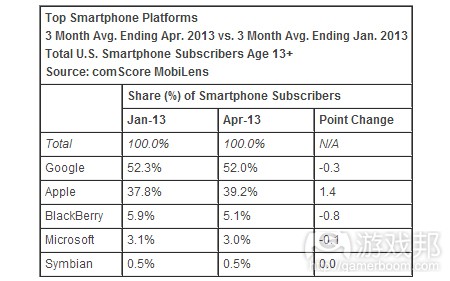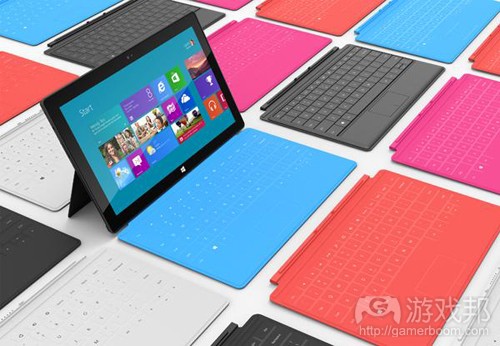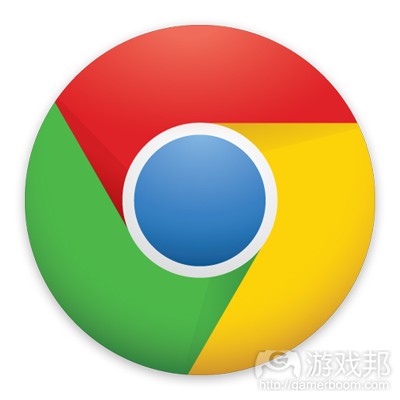每日观察:关注全球主流应用商店市场规模(6.6)
1)comScore最新报告显示,2013年1月至4月,苹果iPhone在美国手机设备市场份额将近40%,增长1.4个百分点,使苹果成为美国发展最快的头号移动设备制造商。
尽管iPhone是最抢手的移动设备,但最具人气的操作系统仍是Android,其市场份额为52%,但已下降0.3个百分点。
三星在美国手机设备市场中占比22%,而HTC、摩托罗拉和LG市场份额均有所下滑。
值得注意的是,Kantar Worldpanel最近报告称Windows Phone市场份额已占比5.6%,成为第三大手机平台,而comScore报告则认为Windows Phone占比仅为3%,黑莓(占比5.1%)仍是第三大手机平台。
2)IDC最新数据显示,2013年第一季度中东和非洲地区平板电脑销量达225万台,同比上年增长184%。
报告称Windows平板电脑是该地区平板电脑销量增长的主要动力,因为该地区企业更青睐Windows平板设备;原先预计苹果iOS在该地区将持续失势,但iPad Mini在该地区市场的需求增长速度却远超过预期。Android低价平板电脑(100美元以下)需求增长与Windows设备对苹果在该地市场份额构成了威胁。
3)NetMarketShare最新数据指出,Safari仍是最受欢迎的移动浏览器。Android浏览器在4月至5月间流失2个百分点,Chrome在此期间增长不足1个百分点。谷歌于去年秋季开始在Android设备中预装Chrome,推动Chrome市场份额从去年7月的0.34T增长至今年5月的3.22%。
但Android浏览器在过去11个月中整体市场份额并没有明显变化,可见Chrome份额增长主要来自新设备销量,而非用户更换浏览器的结果。
4)TopApps.net最近发布信息图表显示了各主流手机应用商店发展历程,并指出游戏是目前最具人气的应用类型,所占市场份额达33%,其次是小工具(占比8%),第三是娱乐应用(占比7%)。
最受欢迎的主流应用商店分别是苹果App Store(含85万款应用),亚马逊Appstore(7.5万款应用),黑莓App World(12万款应用),谷歌Google Play(超过80万款应用),Nokia store(11万6583款应用),微软Windows Phone Store(14.5万款应用),三星乐园(1.3万款应用)。
据ABI Research今年1月报告显示,从市场份额及盈利情况来看,苹果App Store是最佳应用商店,其次是Google Play,第三是Windows Phone Store。
从应用数量来看,游戏是在苹果App Store和Google Play中比例最高的应用类型,分别占比17%和15%。黑莓App World占比最高的是书籍应用(15%),其次才是游戏(9%);Windows Phone Store中占比最高的是娱乐应用(19%),其次是工具&办公应用(15%),第三才是游戏(12%)。
目前全球用户最多的通讯应用分别是Facebook Messenger(7亿用户),微信(3亿用户)以及What’s App(2亿用户)。
Mobyaffiliates最近调查发现全球有70个应用商店,其中跨平台应用商店有26个,Android应用商店有13个,iOS应用商店有5个,黑莓有3个,运营商应用商店有16个。
(本文为游戏邦/gamerboom.com编译,拒绝任何不保留版权的转载,如需转载请联系:游戏邦)
1)iPhone now accounts for 4 out of every 10 smartphones in the US
by Keith Andrew
The latest numbers for the US market published by comScore depict a region dominated by two forces – Apple and Google – just as it has been for some time.
The firm’s sweep of smartphone subscriber market share for the months January to April 2013 peg Apple’s iPhone as the top handset, with a near 40 percent share of the market.
That’s also up 1.4 percentage points, making Apple the fastest growing OEM within the top five, despite already being top dog.
However, despite iPhone being the top handset, Android remains the most popular operating system, with a 52 percent share of the market.
Tighter at the top
Indeed, comparing that to Samsung’s 22 percent share of the handset market suggests that the Korean giant isn’t quite as dominant within the Android scene as previously suggested.
That’s despite the fact that all three of its main rivals on Google’s OS (HTC, Motorola and LG) lost share during the three month period.
Samsung’s Galaxy S4 acts as Android’s flagship
As a result, iOS is actually gaining ground on Android, with Google’s share down 0.3 percentage point compared to Apple’s aforementioned 1.4 percentage point rise.
Interesting, comScore’s figures offer a somewhat different take to recent numbers released by Kantar Worldpanel when it comes to judging which platform has snapped up third spot.
While Kantar claimed Windows Phone boasts a 5.6 percent share, comScore has the platform somewhat further behind on 3 percent, with BlackBerry on the slide but holding third spot with a 5.1 percent share.(source:pocketgamer)
2)Tablet market in the Middle East and Africa grows 184 per cent in Q1
by Zen Terrelonge
Results are described as ‘remarkable’.
New IDC research shows that tablet sales in the Middle East and Africa (MEA) reached 2.25 million in Q1 2013, which is a 184 per cent year-on-year increase.
The firm describes the growth as ‘remarkable,’ with consumer adoption powering the growth while supported by ‘steady’ business usage. In particular, it was Microsoft responsible for supporting the enterprise market, as MEA companies showed a fondness for Windows-based tablets.
Victoria Mendes, research analyst for personal computing, systems, and infrastructure solutions at IDC, said: “Growing demand from the commercial segment is expected in the coming years, especially within the education sector.
“Education projects like ‘Fatih’ in Turkey, the Supreme Education Council’s (SEC) ‘e-bag’ project in Qatar, and Sheikh Mohammed’s ‘Smart learning’ initiative in the UAE are expected to drive commercial tablet sales in the coming years. The banking sector and the aviation sub-sector are expected to be other key spending industries.”
Desktop PC OEMs originally expected Windows 8 to increase their tablet market share, but they’re now pushing Android at equally competitive prices to compete with rivals. An increasing number of Android tablets are priced at sub-$100 and the Google OS and Windows are set to damage Apple’s regional performance.
Fouad Charakla, research manager at IDC, added: “Apple’s proprietary operating system, iOS, is expected to continue losing share across the MEA region. However, the rapidly growing demand for the iPad Mini is expected to enable the vendor’s volumes to grow at a much faster pace than previously forecast.”(source:mobile-ent)
3)Chrome Starts To Take Off In Mobile Browser Share, But Android Dips Among Mobile Operating Systems
DARRELL ETHERINGTON
Among mobile browsers, Safari continues to lead the pack by a wide margin, according to this month’s data from NetMarketShare. But the real movement is happening within the Android segment, with Chrome growing fast as the stock Android browser lags behind. Android overall dipped slightly in May in terms of mobile OS share, hitting an eight-month low, according to
NetMarketShare’s tracking.
Android’s stock browser lost over 2 percentage points of share between April and May, and Chrome mobile gained just under a full percentage point. Google has been pushing the mobile
version of Chrome, shipping it on devices with Android pre-installed since last fall. That has resulted in a steady upwards movement of share, growing from 0.34 percent last July to 3.22 percent this past May. Stock Android browser share is actually flat over that 11-month period, however, indicating that Chrome’s share is all coming in new device sales, and not as a result of people switching from one to the other on their own devices.(source:techcrunch)











































 闽公网安备35020302001549号
闽公网安备35020302001549号